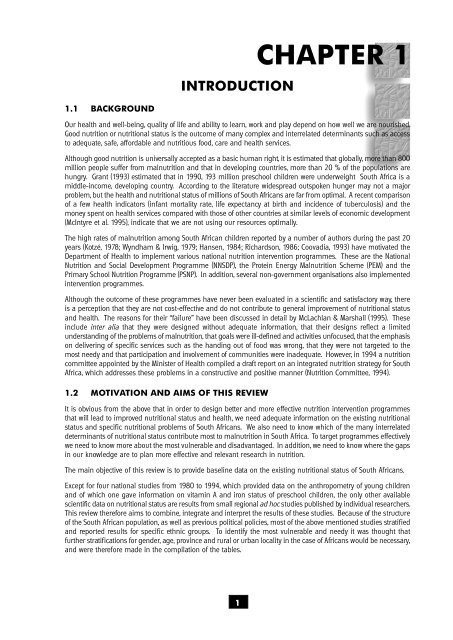the nutritional status of - Health Systems Trust
the nutritional status of - Health Systems Trust
the nutritional status of - Health Systems Trust
Create successful ePaper yourself
Turn your PDF publications into a flip-book with our unique Google optimized e-Paper software.
INTRODUCTION<br />
CHAPTER 1<br />
1.1 BACKGROUND<br />
Our health and well-being, quality <strong>of</strong> life and ability to learn, work and play depend on how well we are nourished.<br />
Good nutrition or <strong>nutritional</strong> <strong>status</strong> is <strong>the</strong> outcome <strong>of</strong> many complex and interrelated determinants such as access<br />
to adequate, safe, affordable and nutritious food, care and health services.<br />
Although good nutrition is universally accepted as a basic human right, it is estimated that globally, more than 800<br />
million people suffer from malnutrition and that in developing countries, more than 20 % <strong>of</strong> <strong>the</strong> populations are<br />
hungry. Grant (1993) estimated that in 1990, 193 million preschool children were underweight South Africa is a<br />
middle-income, developing country. According to <strong>the</strong> literature widespread outspoken hunger may not a major<br />
problem, but <strong>the</strong> health and <strong>nutritional</strong> <strong>status</strong> <strong>of</strong> millions <strong>of</strong> South Africans are far from optimal. A recent comparison<br />
<strong>of</strong> a few health indicators (infant mortality rate, life expectancy at birth and incidence <strong>of</strong> tuberculosis) and <strong>the</strong><br />
money spent on health services compared with those <strong>of</strong> o<strong>the</strong>r countries at similar levels <strong>of</strong> economic development<br />
(McIntyre et al. 1995), indicate that we are not using our resources optimally.<br />
The high rates <strong>of</strong> malnutrition among South African children reported by a number <strong>of</strong> authors during <strong>the</strong> past 20<br />
years (Kotzé, 1978; Wyndham & Irwig, 1979; Hansen, 1984; Richardson, 1986; Coovadia, 1993) have motivated <strong>the</strong><br />
Department <strong>of</strong> <strong>Health</strong> to implement various national nutrition intervention programmes. These are <strong>the</strong> National<br />
Nutrition and Social Development Programme (NNSDP), <strong>the</strong> Protein Energy Malnutrition Scheme (PEM) and <strong>the</strong><br />
Primary School Nutrition Programme (PSNP). In addition, several non-government organisations also implemented<br />
intervention programmes.<br />
Although <strong>the</strong> outcome <strong>of</strong> <strong>the</strong>se programmes have never been evaluated in a scientific and satisfactory way, <strong>the</strong>re<br />
is a perception that <strong>the</strong>y are not cost-effective and do not contribute to general improvement <strong>of</strong> <strong>nutritional</strong> <strong>status</strong><br />
and health. The reasons for <strong>the</strong>ir “failure” have been discussed in detail by McLachlan & Marshall (1995). These<br />
include inter alia that <strong>the</strong>y were designed without adequate information, that <strong>the</strong>ir designs reflect a limited<br />
understanding <strong>of</strong> <strong>the</strong> problems <strong>of</strong> malnutrition, that goals were ill-defined and activities unfocused, that <strong>the</strong> emphasis<br />
on delivering <strong>of</strong> specific services such as <strong>the</strong> handing out <strong>of</strong> food was wrong, that <strong>the</strong>y were not targeted to <strong>the</strong><br />
most needy and that participation and involvement <strong>of</strong> communities were inadequate. However, in 1994 a nutrition<br />
committee appointed by <strong>the</strong> Minister <strong>of</strong> <strong>Health</strong> compiled a draft report on an integrated nutrition strategy for South<br />
Africa, which addresses <strong>the</strong>se problems in a constructive and positive manner (Nutrition Committee, 1994).<br />
1.2 MOTIVATION AND AIMS OF THIS REVIEW<br />
It is obvious from <strong>the</strong> above that in order to design better and more effective nutrition intervention programmes<br />
that will lead to improved <strong>nutritional</strong> <strong>status</strong> and health, we need adequate information on <strong>the</strong> existing <strong>nutritional</strong><br />
<strong>status</strong> and specific <strong>nutritional</strong> problems <strong>of</strong> South Africans. We also need to know which <strong>of</strong> <strong>the</strong> many interrelated<br />
determinants <strong>of</strong> <strong>nutritional</strong> <strong>status</strong> contribute most to malnutrition in South Africa. To target programmes effectively<br />
we need to know more about <strong>the</strong> most vulnerable and disadvantaged. In addition, we need to know where <strong>the</strong> gaps<br />
in our knowledge are to plan more effective and relevant research in nutrition.<br />
The main objective <strong>of</strong> this review is to provide baseline data on <strong>the</strong> existing <strong>nutritional</strong> <strong>status</strong> <strong>of</strong> South Africans.<br />
Except for four national studies from 1980 to 1994, which provided data on <strong>the</strong> anthropometry <strong>of</strong> young children<br />
and <strong>of</strong> which one gave information on vitamin A and iron <strong>status</strong> <strong>of</strong> preschool children, <strong>the</strong> only o<strong>the</strong>r available<br />
scientific data on <strong>nutritional</strong> <strong>status</strong> are results from small regional ad hoc studies published by individual researchers.<br />
This review <strong>the</strong>refore aims to combine, integrate and interpret <strong>the</strong> results <strong>of</strong> <strong>the</strong>se studies. Because <strong>of</strong> <strong>the</strong> structure<br />
<strong>of</strong> <strong>the</strong> South African population, as well as previous political policies, most <strong>of</strong> <strong>the</strong> above mentioned studies stratified<br />
and reported results for specific ethnic groups. To identify <strong>the</strong> most vulnerable and needy it was thought that<br />
fur<strong>the</strong>r stratifications for gender, age, province and rural or urban locality in <strong>the</strong> case <strong>of</strong> Africans would be necessary,<br />
and were <strong>the</strong>refore made in <strong>the</strong> compilation <strong>of</strong> <strong>the</strong> tables.<br />
1
















